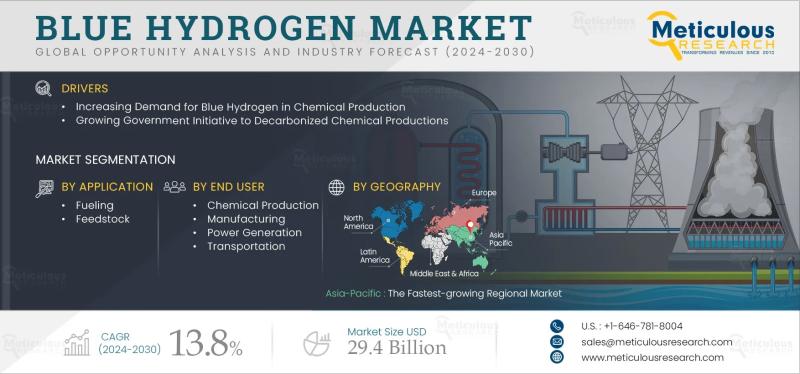Decarbonizing the Future: Blue Hydrogen Market Set to Reach $29.4 Billion by 2030
Key Ideas
- The global blue hydrogen market is projected to grow to $29.4 billion by 2030, driven by a CAGR of 13.8% as industries focus on reducing carbon emissions and decarbonizing operations.
- Challenges facing blue hydrogen adoption include energy inefficiency in production processes, infrastructure integration with natural gas networks, and the need for cross-sector collaboration and regulatory support.
- Technological advancements and the integration of carbon capture utilization and storage (CCUS) technologies are expected to enhance the sustainability and economic viability of blue hydrogen, fostering market growth.
- Detailed segment analysis highlights steam methane reforming as the dominant generation process, with gasification poised for significant growth, while methane remains the leading energy source for blue hydrogen production.
Meticulous Research® has published a detailed report on the blue hydrogen market, projecting its value to reach $29.4 billion by 2030 with a robust CAGR of 13.8%. The global push to combat climate change has elevated the importance of blue hydrogen, serving as a transitional source between traditional fossil fuels and a sustainable future.
The report outlines the market dynamics driving this growth, emphasizing the increasing focus on decarbonization within industries and governments worldwide. While blue hydrogen offers a promising solution to reduce greenhouse gas emissions through carbon capture and storage (CCS) technologies, challenges such as energy inefficiency and infrastructure integration hinder widespread adoption.
Despite these obstacles, ongoing technological advancements and the utilization of carbon capture technologies are expected to propel the market forward. Steam methane reforming (SMR) currently leads in generation processes, with gasification showing potential for growth due to its versatility and cost-effectiveness in converting various feedstocks into hydrogen.
The report also highlights methane as the primary energy source for blue hydrogen production, driven by its abundant availability and economic viability. As the market evolves, innovations in autothermal reforming (ATR) and partial oxidation are gaining traction, offering more efficient and environmentally friendly alternatives for blue hydrogen production.
In conclusion, the blue hydrogen market is poised for significant expansion, supported by technological innovations and a growing emphasis on sustainable energy solutions. The integration of CCUS technologies and advancements in generation processes are expected to shape the future landscape of blue hydrogen production, paving the way for a more sustainable energy mix.
Topics
Blue Hydrogen
Carbon Emissions
Energy Efficiency
Market Analysis
Infrastructure Challenges
Carbon Capture
Technological Advancements
CCUS Technologies
Global Energy Mix
Latest News
